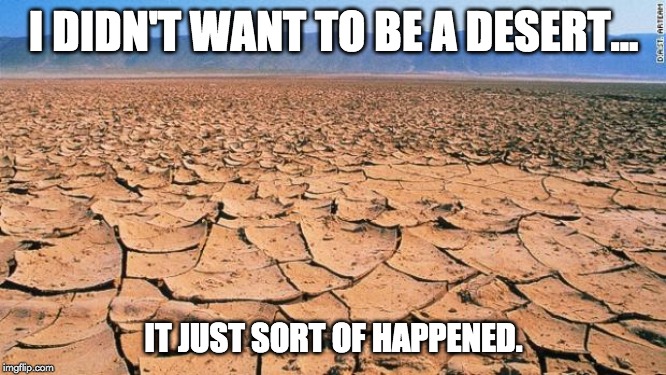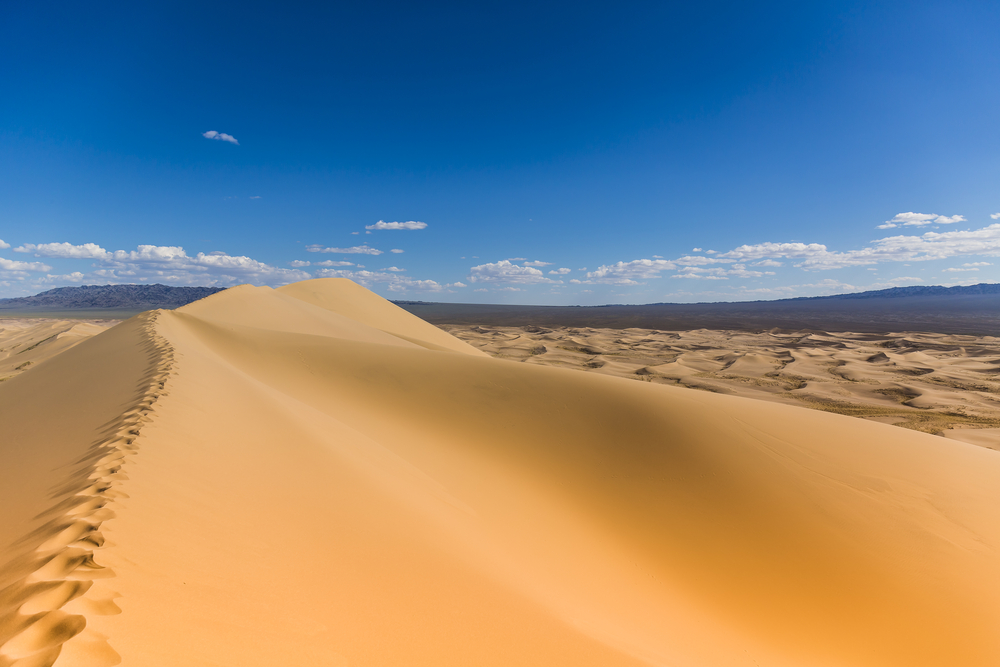Table of Contents (click to expand)
The majority of deserts on Earth are not, in fact, covered by sand, but are instead composed of exposed bedrock and desert stone, along with rocky outcrops and clay, depending on the surrounding topography, geological makeup and weather patterns.
When the word “desert” is mentioned, most people envision the undulating dunes of the Sahara, massive piles of shifting sand as far as the eye can see. This is what movies, television shows and popular culture have told us about deserts, but this is far from the whole story. Yes, there is an incredible amount of sand in the deserts of the world, which does beg the question of what is under the golden carpet, but in most areas of the desert, there is very little sand, so we can easily see what lies beneath!
Desert Formation
In terms of a formal definition, a desert is typically characterized by an extreme lack of rainfall. One of the prime causes behind an area that receives little rainfall is being on the “wrong side of the mountain”. To understand this, you must consider the behavior of air and moisture when it encounters an obstacle. For example, consider a weather system blowing in from the west and bumping into a north-south mountain range. The damp, warm air that rolled up against the base of the mountain will now begin to rise and form clouds. However, as the air rises, it begins to cool, causing it to release its moisture in the form of precipitation.
Rain Shadow
By the time the air moves over the top of the mountain range, it is largely devoid of moisture, save for a few clouds that don’t produce much precipitation. The east side of the mountain is called a “rain shadow”, and the air will descend and warm up, but will not have any moisture to speak of. This often results in hot, dry winds that can exacerbate the formation of a desert over the course of thousands or millions of years.

That being said, some deserts on the planet aren’t located near mountains, and are instead the result of unique weather patterns on a regional scale. High-pressure systems are full of warm, heavy air, and in subtropical or semi-permanent high-pressure systems, such as the one found in the region of the Sahara, that air cannot rise, cool, form clouds and generate precipitation. Furthermore, if a high-pressure system is strong and stable, it makes it very difficult for low-pressure systems to move in and generate variability in weather patterns. As a result, you have a region that receives very little rain, is buffeted by dry winds, and doesn’t benefit from the movement of cold fronts.
While most deserts are characterized by scorching heat, there are also cold deserts, such as the Gobi Desert, the entire continent of Antarctica, or the coastal desert of Peru and northern Chile, where the air is so cold that it cannot hold moisture to generate precipitation. While the surface of the Antarctic desert is snow and ice, gusting crystals of ice and dry winds create similar conditions, with white-out windstorms replacing classic desert sandstorms.

Over the course of millions of years, these weather patterns and topographical factors result in a land that is largely bereft of any vegetative cover, as there is often too little water to support life, and the ever-changing landscape makes it difficult for root systems to take hold. These deserts are also susceptible to temperature shifts, since they gain and lose heat very easily. Unlike cities, jungles and grasslands, desert sand is unable to hold onto its heat effectively, so while it may be extremely hot during the day, the ground doesn’t hold that heat into the night, resulting in drastic temperature swings, yet another obstacle to life thriving.
Also Read: Why Are Deserts Hot And How Are They Formed?
Where Does The Sand Come From?
Although we partially debunked the idea that deserts are completely covered with sand, the question remains—where does the sand come from in the first place? As mentioned in the section above, the drastic shifts in temperature between day and night can put stress on the rocks of a region, which may split and crack.

Combine this with the dry, gusting winds that readily cause erosion, and you get a great deal of sand being formed over the course of millennia. The sand will basically sort itself by size, with the larger and heavier pieces of broken down sand at the bottom, and the fine, silt-like sand on the surface, where it can be whipped around and blown into dunes, or further aid the weathering process of wind erosion.
Sand behaves as a very abrasive substance, and with the wind stripping the earth down to its rocky bones, some very unusual rock formations and outcroppings (Aeolian landforms) may be molded by the power of gusting sand alone. Dune seas are ever-shifting landscapes that are grown and molded by the wind into various recognizable formations, but they may rise and fall in a matter of years.
Finally, not all deserts are composed of sand. There are erg (sand deserts), serrir (pebble deserts) and hammada (rock deserts), each of which is shaped by their unique erosion patterns and climate. Some areas of a desert may be characterized by dunes and sand, but other desert regions may simply be barren, which brings us to the last question of this article.
Also Read: Why Is There Sand On Beaches?
What Is Underneath The Sand?
Now that you understand where sand comes from, and why deserts form, you may already be able to guess what lies beneath the swirling sand. Roughly 80% of deserts aren’t covered with sand, but rather show the bare earth below—the bedrock and cracking clay of a dried-out ecosystem. Without any soil to cover it, nor vegetation to hold that soil in place, the desert stone is completely uncovered and exposed to the elements.
A desert is not necessarily flat, so there are hills and rock formations that are either weathered down to a flat earth below, or shaped into outcroppings through the forces of erosion. Rolling plains of dunes may also hint at rolling hills that once existed beneath them. The type, color and hardness of the surface rock is dependent on the geologic characteristics of the region. There is a very good chance that the exposed areas of a desert are the same as those that are covered by sand, provided they are geographically close. Furthermore, as deserts “grow”, it isn’t that the sand is spreading out, but rather the ecosystems on the edges of the desert are similarly giving way as the soil blows away, vegetation decreases and the erosive processes begin!
A Final Word
Deserts may seem like forbidding and mysterious places, but they are the result of completely natural processes of erosion and weather patterns. Next time you’re watching a nature documentary and they show a sweeping shot over a sea of dunes, remember that is only a fraction of what the whole desert looks like. The aesthetic beauty of swirling sand can’t compete with the barren and brutal landscape of a rocky desert where the wind-scarred bedrock has been exposed.
There will always be secrets hidden under the sand, but what lies at the very bottom is rather easy to discover—simply find another area nearby that has been scrubbed clean over the millennia… it should give you a reliable clue!
Also Read: Do We Need Deserts On The Planet?
How much do you know about deserts?

